May 31, 2023 – Volume 25, Issue 5
In This Issue
- Flanigan’s Eco-Logic: Crafting Intentional Community
- Rechargeable Batteries
- Dutch Solar Cycling Paths
- Long Beach Plans Offshore Wind Hub
- Tribal and Chinese Storage Projects
- Rural Electrification 101
- Flanigan’s Ego-Logic Podcast Updates
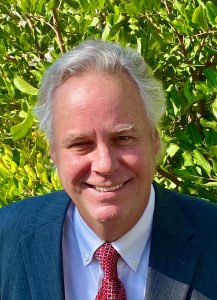
Flanigan’s Eco-Logic: Crafting Intentional Community
Many of us aspire to lead a sustainable life. We lower our footprints and triumph internally. We address the spheres of sustainability – our energy use, water, material management, the built and natural environments…. But what about well being? How do we feel? How at ease are we? Daily anxiety? How supported do we feel? Do you feel? Do I feel?
EcoMotion graphically depicts the path to a sustainable lifestyle. One leg of the stool, one pillar, is health and wellbeing.
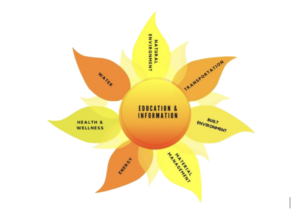
Health is about what you eat. It’s about working out, and helping others out. It’s about being engaged socially and volunteering. This week I read about an intentional community. I love the notion of leading a life of intentionality, and living in an intentional community. This article features one such story from Portland, Oregon.
Intentional communities can be many things. They can be perceived as social or communal experiments, some of which work out just fine! The term covers collective households, cohousing communities, ecovillages, monasteries, ashrams, housing cooperatives, and more. Intentional communities are voluntary residential communities designed to have a higher degree of social cohesion and teamwork.
On the flip side are “single-use neighborhoods.” Never heard that term before but I get it. Single-use plastics are shortsighted. Single-use neighborhoods? Hey, I grew up on Long Island and know my Levittowns and their developments of cookie-cutter homes. The single-use bedroom communities that many of us live in, myself included, are designed without intention for social interaction or wellbeing through diversity.
Multiple-use developments are rich. They are deliberate, intentional, They thrive on ethnic, age, and gender diversity. They provide lots of uses… places to live, to eat, to socialize, to work, to garden, to play music, to learn. They are walkable and bike-able. They mix housing with commerce and culture. They rely on webs, ecosystems, and integration; they literally and figuratively serve companion planting.
Village Homes in Davis, California, was a cutting-edge co-housing project that was built in the 1970s. It features rainwater and solar harvesting, plus shared permaculture landscapes. The project was built out in 1982 as a model of environmentally friendly housing and drew the interest of many and a visit from French President Francois Mitterrand.
Nice story from Portland, Oregon where a couple bought a dilapidated building in 2007 and turned it into an intentional community brimming with community gardens. It’s now a thriving eco-village. Four miles from Pioneer Square in the Portland city center, the place was rundown, most units unlivable, some taken over by the unhoused.
Ole and Maitri Ersson had a vision: The first order of business was to tear up the parking lot, to “un-pave paradise.” They also tore up the lawn and in-filled pool and replaced them with an orchard, vineyard, berry patches, and vegetable gardens. They remodeled 50 apartments, all with composting toilets. The building has solar panels that provide 75% of the power requirement there, and a rainwater harvesting system to complement a 100-foot well. There are bee hives, there’s composting, plus “humanure” and urine-fertilizer processing facilities.
Today the two-acre parcel is a cornucopia producing lots of fruits and vegetables. It is nearly independent in terms of electricity, water, sewer, and trash. Residents use shared electric vehicles, bicycles, and gardening tools. One bedroom apartments are for rent for $1,000, and residents are expected to work at least an hour a month in the community garden. Named Kailash EcoVillage, there is now a 300+ waiting list for rentals there. Lots of Portlanders are eager to sign up for this intentional community’s “community membership.”

Image Courtesy of Ole Errson of Kailash Ecovillage
The Foundation for Intentional Communities has a website that features resources: books, directories, a podcast, guides and toolkits. Its mission is to support and promote the development of intentional communities as pathways towards a more sustainable and just world.
Quote of the Month
“Imagine fully assembled wind turbines capable of generating 20 megawatts of energy towed by sea from the Port of Long Beach to offshore wind farms in Central and Northern California.”
Rechargeable Batteries

Last month’s article on properly disposing of alkaline batteries drew a number of comments. One of my favorite comments was, “Why not advocate rechargeable batteries?” The reader noted that he recharges his AAs and AAAs as many as 100 times. That keeps them out of the landfill doesn’t it? I agree with the reader and pledge to purchase rechargeable batteries for my remotes after studying the matter.
Forget the Energizer Bunny. It’s a myth. Those batteries die too, unless you buy Energizer’s rechargeable batteries! Popular Mechanics reports that, “… if you opt for disposable, single-use batteries, you’re contributing to the estimated 3 billion of them that end up in the landfills each year…. Go the rechargeable route and replacing batteries is much less of a drain on your wallet and the environment.” You can generally recharge a rechargeable battery a hundred times. Some batteries can handle more than a thousand recharges.
AA and AAA rechargeable batteries come in two main types, nickel metal hydride (NiMH) and lithium-ion (Li). NiMN are more popular and have been available longer. NiMH generally outlast lithium ones, they retain their power better when sitting on the shelf or in a remote or digital camera or wall clock. On the other hand, lithium batteries are a bit stronger, 1.5 volt output vs 1.2 for NiMH. Thus, the rechargeable lithium-ion batteries are better for motorized products such as electric toothbrushes. Then there’s recharging: It takes 3-7 hours to recharge NiMH, one or two for lithium.

There are markedly small marginal costs and huge lifecycle benefits of rechargeable batteries. I did the math using Amazon prices. An 8-pack of Duracell Power Boost AAs costs $7.24. Eight Panasonic Eneloop rechargeable batteries — which can be recharged 2,100 times — cost $24.48, plus $11.99 for an 8-battery charging bay. So for $36.47, I now have eight batteries that can be recharged 2,100 times. Thus I could avoid the purchase of 2,099 single use battery sets at a cost of $15,196! Yes, that’s a pathway to thousands of dollars of savings over time. What a deal. Taxes and shipping not applied.
Dutch Solar Cycling Paths
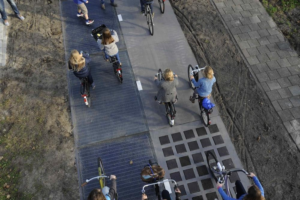
Image Courtesy of SolaRoad
The Netherlands, in the Dutch province of North Brabant, a new, 500-meter long solar bike path is being built. It’s one of several similar installations being used to test the efficacy of solar systems embedded in pavement over a five-year period. At this installation, 600 panels will be integrated into the bike path’s asphalt layer. This path will be along the provincial NM285 near Wagenberg.
Two similar systems have been deployed along the N395 near Oirschot, and along the N324 near Grave, also in North Brabant. The Netherlands features other “solar roads.” There’s a solar bike path near Amsterdam and another in the province of Utrecht. These projects are part of the Dutch government plan to test the viability of solar embedded in paths, along highways, and on noise barriers.

Dutch authorities are struggling to find places to cite solar due to scarcity of land. Thus they are looking at non-agricultural land, dikes, rooftops, as well as onshore and offshore water surfaces. This new bike path and others will serve as test cases, assessing the resistance mechanical stress of pedestrians and bikers.
Long Beach Plans Offshore Wind Hub
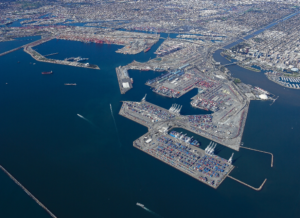
Image Courtesy of The Port of Long Beach
The Port of Long Beach is planning a project called “Pier Wind” that would support the manufacture and assembly of offshore wind turbines on the West Coast of the United States. The facility would span 400 acres of newly built land within Long Beach’s Harbor District. Construction could start in 2027 for partial operations in 2031. Second and third phases would be complete by 2035. It’s a $4.7 billion project and the Port is negotiating with federal and state officials for support.
Long Beach claims that its harbor is ideally located for such an enterprise, with calm seas behind a federal breakwater. It’s one of the deepest and widest channels in the United States with direct access to the open ocean and no air height restrictions. The Port believes that no other location has the space to achieve the economies of scale needed to drive down the cost of energy for these huge turbines.
In December of 2022, the U.S. Bureau of Ocean Management (BOEM) selected the winners of California’s first offshore wind lease sale. RWE Offshore Wind Holdings, Equinor Wind US, Invenergy California Offshore, California North Floating, and Central California Offshore Wind won the rights to develop floating wind projects across five leas areas in Humboldt Bay and in Morro Bay, off the northern and central coasts of California. The areas have an installation capacity of 4.5 GW.
Pier Wind could contribute toward lowering the cost of offshore wind power and to meeting California’s goal of producing 25 GW of offshore wind power by 2045. Furthermore, the project could bring lots of jobs to communities closest to the port which have been adversely impacted by climate change and local air pollution. Given major advances in floating wind turbines, hubs like these are popping up around the world, from Brooklyn, New York to New London, Connecticut, and Louisiana, and potentially at Port Taranaki in New Zealand.
Port Esbjerg, in Denmark, is the the world’s largest base port for offshore wind activities. It has been involved in shipping components to more than 60 offshore wind projects including Dogger Bank wind farms in the south North Sea of the United Kingdom. The port is one of the world’s largest originating ports for wind power, shipping out up to 1,500 MW of offshore wind turbines each year. Port Esbjerg is also home to more than 200 businesses that employ over 10,000 people.
Tribal and Chinese Storage Projects
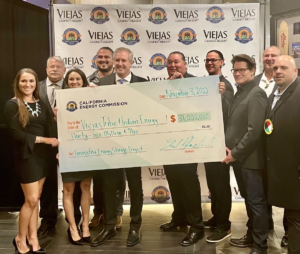
Image Courtesy of The California Energy Commission
The California Energy Commission has issued a $31 million grant to build a 60 MWh long-duration energy storage system to provide backup power to the Viejas Tribe of Kumeyaay Indians and bolster the reliability of the energy system. It is the largest grant for an energy project ever given to a tribe in California. The battery storage will be paired with ~30,000 photovoltaic panels for ~15 MW of capacity. Initial installation is pegged for 2023 with the entire project slated to be online in 2024.
The project will include 10 MWh of vanadium redox flow batteries developed by Invinity Energy Systems. This is expected to be the largest deployment of flow batteries in the country. The flow batteries will be paired with a 35 MWh 10-hour zinc hybrid cathode battery system developed by Eos Energy Enterprises. The remaining 15 MWh will be lithium-ion technologies.
So far, more than 4 GW of battery storage has been installed in the California Independent System Operator footprint, and the State projects that it will need 48 GW of long duration energy storage by 2045. This is the first project to be awarded in the State’s $140 million long-duration energy storage incentive fund. It will be developed by Indian Energy, a Native American owned microgrid developer.
Shifting technologies and continents, let’s revisit gravity storage. Energy Vault, the Swiss company known for its huge cranes and blocks, is now completing a gravity energy storage project near Shanghai in China. The systems are touted as very basic and loosely translated, “they lift heavy things and when energy is needed, the thing can fall.” At that time, potential energy is converted back into electricity.
Energy Vault’s gravity-based storage system does not rely on land topography or geology and can be built almost anywhere. The systems can be co-located with wind or solar projects, or be built alone to support grid stability through dispatch. Conceptually, Energy Vault is an alternative to conventional pumped storage hydropower. Instead of lifting water, Energy Vault lifts cement/polymer-based composite bricks.
The bricks can be made of ultra-low-cost material such as soil, mine tailings, coal ash, and incinerated city waste. Energy Vault takes material that would otherwise be landfilled and repurposes it for gravity storage. Each brick is designed to weigh 35 metric tonnes and engineered to have a specific gravity (or relative density) at least twice that of water.
Energy Vault’s original system consisted of a combination of blocks and a tall tower. Cranes lifted blocks 35 stories into the air. Now the towers have been replaced by large buildings that house hoists internally. The Energy Vault Resilience Center, a mechanical process and energy management system, raise 30-ton bricks. When needed, the bricks are lowered in elevator shafts releasing kinetic energy back to the grid. Each brick lowered at six feet per second can generate a megawatt of power. The systems can be scaled in 10 MWh units.
For a waste management and recycling company in China, Energy Vault is building 25 MW / 100 MWh of energy storage capacity, expected to be complete in June 2023. The facility being built for the China Tianying Group (CCNTY) in Rudong, China, is under construction and looks like a huge, multistory warehouse. The “EVx Gravity Energy Story System” is adjacent to a wind farm in the Jiangsu Province outside of Shanghai. The facility’s dispatchable capacity will feed into the State Grid Corporation of China, the world’s largest utility, serving power to 1.1 billion citizens.
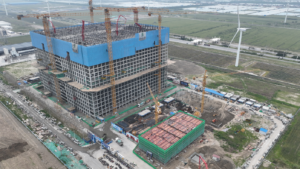
Meanwhile, Energy Vault announced in January that it is working with Pacific Gas and Electric to develop a 293 MWh hybrid system for the City of Calistoga, California to provide 48 hours of resilience during Public Safety Power Shut-off (PSPS) events. In this case, energy will be stored in the form of green hydrogen and in batteries.
Rural Electrification 101
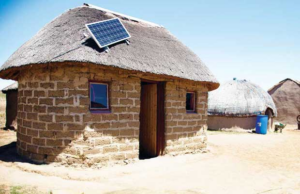
In 2019, 770 million people lived without access to electricity – 10.2% of the global population in that year. That number is likely smaller now, perhaps 500 million, 22 times the population of the New York Metropolitan area… but spread in rural and remote areas… often islands.
Rural electrification is the process of bringing electrical power to these areas. Bringing electricity to the last 5% is the most difficult as the unit cost of hookups is greater in sparsely populated areas. Developing countries are impeded with rural electrification given the high capital costs of power system infrastructure.
The social benefits of having access to electricity are profound and multiple: Increased education and literacy thanks to light. Schools can recruit better teachers, students get higher test scores, raising the human capital entering the workforce. Electrification boosts productivity and efficiency. Businesses keep their doors open longer and earn additional revenues.
With electricity, farmers have access to modern controls for irrigation, crop processing, and food preservation. Health care gets a lot better. Refrigerators safely store and extend the life of vaccines. Electrification reduces isolation thanks to telephone lines and television. There is improved safety with street lighting, less purchasing of expensive kerosene.
Sustainable Development Goal 7 (SDG7 or Global Goal 7) is one of the 17 sustainable development goals established by the United Nations General Assembly in 2015. It aims to, “Ensure access to affordable, reliable, sustainable and modern energy for all.” Energy is considered an important pillar for wellbeing.
There are currently 46 countries designated by the United Nations as Least Developed Countries (LDCs). This status is based on three criteria: The first is that gross national income per capita must be less than $1,025. It is also based on human assets including nutrition, health, education, and literacy as well as the country’s economic vulnerability.
Of the 46 LDCs, 33 are in Africa, nine are in Asia, three are in the Pacific and one is in the Caribbean (Haiti). Some LDCs are slated for graduation, such as Bhutan in 2023 and the Solomon Islands in 2024.
Despite the benefits of and the U.N.’s focus on rural electrification, over half the people in the Least Developed Countries (LDCs) lack access to electricity. This represents about two-thirds of the world population without electricity. Even in some LDC urban centers, a third of the people do not have electricity.
Electrification generally begins in cities and towns and then expands outward… gradually. The challenge has been figuring out how to work directly with rural areas to develop viable models and to leap-frog the typical crawl of electrification.
Options for rural electrification are grid extensions, mini grids, and stand-alone systems, the latter at the building level. Instead of extending central power systems and incurring the cost of grid extensions to sparsely populated areas, mini grids are now being developed. Given the falling costs of batteries, they make more sense. They rely on photovoltaics, small wind electric, diesel/solar hybrids systems (used extensively for telecom systems), bioenergy, and micro hydro. Many systems mix and match resources. These are promising alternatives for rural and remote areas that previously turned toward diesel generators.
Flanigan’s Ego-Logic Podcast Updates
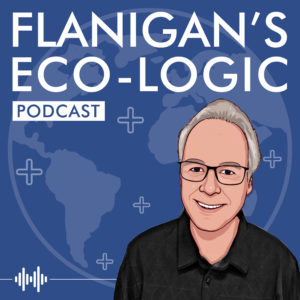
Use the links below to check out our recent podcasts. And you can always go to Spotify and type in “Ted Flanigan” to find our library of podcasts.
Recently Released:

EcoNet News, Volume 25, Issue #5, digs into intentional communities and leading sustainable lives. Ted shares a story out of Portland, Oregon where a couple bought a dilapidated building in 2007 and turned it into an intentional community brimming with community gardens. The issue also highlights rechargeable batteries, Dutch solar cycling paths, the City of Long Beach’s plan to construct an offshore wind hub, tribal and Chinese storage projects, and rural electrification.
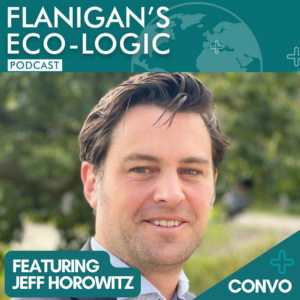
In this episode of Flanigan’s Eco-Logic, Ted speaks with Jeff Horowitz, Director of Business Development and Partnerships at NEXT Energy Technologies.
Jeff is a seasoned market strategy professional with 10 years of experience scaling new businesses in the areas of solar project finance and clean energy. Jeff has negotiated millions of dollars worth of business venture agreements between U.S. and Chinese clean-tech companies and supported the closing of >30 MW of distributed solar energy across the country.
He and Ted discuss his background, growing up in Irvine, CA, attending Claremont McKenna College for his undergraduate degree, and going on to University of California San Diego for his masters degree in Global Policy and Strategy. Jeff also earned a LEED AP certification from the U.S. Green Building Council.
Jeff shares his experiences around traveling and working in China, before diving into his works in the solar industry. He highlights his work at NEXT Energy Technologies developing transparent energy harvesting window technology that allows architects and building owners to transform windows and glass facades into assets as producers of low-cost, on-site, renewable energy. NEXT’s technology is enabled by proprietary organic semiconducting materials that are earth-abundant, low-cost, and are coated as an ink-enabling buildings to power themselves and reduce overall energy consumption.

In this episode of Flanigan’s Eco-Logic, Ted speaks with Sean Armstrong, Managing Principal at Redwood Energy.
Sean has worked for 25 years in building electrification, designed the retrofit and new construction of more than 25,000 all-electric residences for disadvantaged populations, co-authored five practical guides to building electrification, provided legal and technical support to dozens of gas bans nationwide, helped develop the 2016, 2019, 2022, and 2025 Title 24 California Energy Codes, and has received sustainable design awards from the United Nations, the U.S. Department of Energy, and the SoCal Building Industry Association.
He and Ted discuss his background, being a committed environmentalist since the age of 13, growing up in rural Wisconsin as genderqueer, moving to California to flee violence directed toward his sexuality, gender identity, and gender expression, and attending Humboldt State University, where he found his passion for sustainability and was trained in radical activism.
Sean shares his life-changing experience where he lived at the Campus Center for Appropriate Technology (CCAT), a student-run demonstration house that was off-grid (solar, wind, biodiesel and batteries), before diving into his works in California’s affordable housing market. He highlights his work at Redwood Energy, North America’s #1 producer of all-electric, 100+ percent solar housing from 2015 – 2020. Sean’s winning formula is combining all electric solar powered designs with affordable housing developments. This helps developers become more profitable because electric design is cheaper to build and there are incentives for affordable housing.

In this episode of Flanigan’s Eco-Logic, Ted Flanigan speaks with Ted Bardacke, Chief Executive Officer at Clean Power Alliance (CPA), the locally-operated electricity provider for 32 communities and approximately one million customers across Los Angeles and Ventura Counties.
Ted Bardacke is an innovator with a unique career focusing on sustainability and economic development that spans three continents. He and Ted Flanigan discuss his background, growing up in the Bay area, spending time in Mexico, attending Wesleyan University, serving as a foreign correspondent for the Financial Times of London during the 90s in both Mexico City and Bangkok, and then moving back to the states to attend the Graduate School of Architecture at Columbia University.
Prior to CPA, Ted Bardacke worked for Los Angeles Mayor Eric Garcetti, where he was Director of Infrastructure for the City of Los Angeles and Deputy Director of the Mayor’s Sustainability Office. Prior to that, he worked in the Green Urbanism Program at Global Green USA. Ted Bardacke also taught at UCLA’s Luskin School of Public Affairs for 10 years.
In his current role at CPA, Ted Bardacke works with the Board of Directors and CPA’s experienced staff to develop and implement CPA’s strategy to rapidly decarbonize Southern California’s electricity system, provide customer choice and competitive rates, and deliver customer programs that benefit the CPA community.
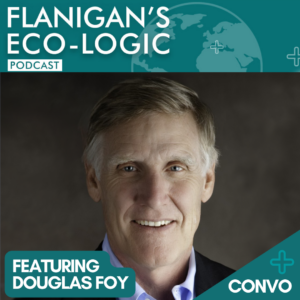
In this episode of Flanigan’s Eco-Logic, Ted speaks with Douglas Foy, Founder and CEO of Serrafix Corporation, a strategic consulting firm and business incubator focused on energy, the environment, transportation, and climate change.
Doug serves on numerous corporate and non-profit boards, including Ameresco, Inc., Renew Energy Partners, the Environmental League of Massachusetts, and the Center for Large Landscape Conservation. Among many awards recognizing his public interest work, Doug has received the President’s Environmental and Conservation Challenge Award (the nation’s highest conservation award), the Woodrow Wilson Award from Princeton University (its highest honor bestowed on a graduate), and the Order of the British Empire (OBE) from the Queen of England.
He and Ted discuss his background, growing up in New Jersey, graduating from Princeton University as a University Scholar in engineering and physics, Cambridge University in England as a Churchill Scholar in geophysics, and from Harvard Law School. Doug was also a member of the 1968 USA Olympic Rowing Team and the 1969 USA National Rowing Team.
Prior to launching Serrafix Corporation, Doug served as the first Secretary of Commonwealth Development in the administration of Massachusetts Governor Mitt Romney. In leading this “super-Secretariat”, he oversaw the agencies of Transportation, Housing, Environment, and Energy. Before his service in the Romney administration, Doug served for 25 years as the President and CEO of the Conservation Law Foundation, New England’s premier environmental advocacy organization.
His current role at Serrafix Corporation is devoted to sustainable business practices and the development of social enterprises, primarily in the areas of energy, housing, smart growth, transportation, and climate change. He shares his belief that the three major players in the fight against climate change are advocacy groups, government, and private enterprise. According to Doug, private enterprise holds the key to the future.
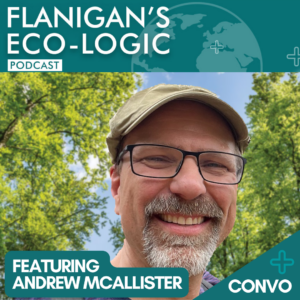
In this episode of Flanigan’s Eco-Logic, Ted speaks with Andrew McAllister, third- term Commissioner at the California Energy Commission.
Andrew has over 30 years of experience in the domestic and international energy arenas, primarily related to policy, utility planning, energy efficiency, and distributed renewable energy. He has worked across the world to deploy clean, cost-effective energy solutions with counterparts ranging from tiny remote communities to the largest of utilities. He administered two of California’s signature renewable energy programs, developed and operated energy efficiency programs for utilities, and conducted a broad range of policy-related research for California and the federal government.
He is a board member and immediate past board chair of the National Association of State Energy Officials, and a board member of the Alliance to Save Energy. His deep grounding in technology, policy, and the marketplace provides him with uncommon insight on the accelerating changes taking place in California’s energy sector.
He and Ted discuss his background, growing up in Nashville, Tennessee, attending Dartmouth College where he started understanding how important energy was when studying engineering. He later served as a Peace Corps volunteer in Costa Rica, and obtained a master of science and a Ph.D. from the Energy and Resources Group at the University of California, Berkeley.
Prior to joining the Energy Commission, he was managing director at the California Center for Sustainable Energy. He worked with the National Rural Electric Cooperative Association International, Ltd. in Central and South America, Southeast Asia, and Africa on renewable generation, load management, utility planning, and remote power projects. He was also a project manager at an energy-consulting firm and an energy efficiency analyst at Lawrence Berkeley National Laboratory.
In his current role at the Energy Commission, he leads the policy area of energy efficiency, including the Building Energy Efficiency Standards, appliance efficiency, and load management and flexibility. More broadly, he is focused on enabling modern, data-rich analytical tools to support strong clean energy policy development and program implementation.
Andrew concludes by sharing his experience walking the walk and talking the talk, putting California’s energy code into practice with the construction of his energy efficient and sustainable home in Davis. Watch the process from start to completion, here: https://www.youtube.com/watch?v=UUbH4Vpt8ZE.
